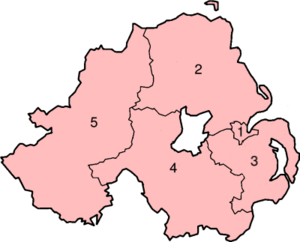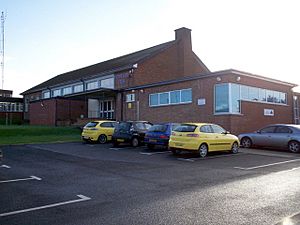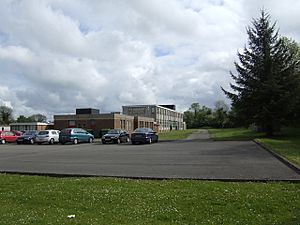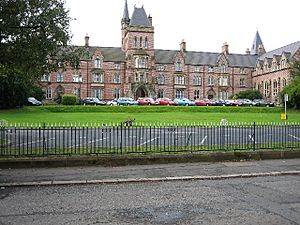Education in Northern Ireland facts for kids
| Department of Education | |
|---|---|
| Minister of Education | Paul Givan MLA |
| National education budget (2021–2022) | |
| Budget | £2.3 billion |
| General details | |
| Primary languages | English, Irish |
| System type | Regional |
| Compulsory education | 1831 |
| Literacy (2003) | |
| Total | 99% |
| Male | 99% |
| Female | 99% |
|
Life in Ireland |
|---|
|
Culture
Economy
General
Society
Politics
Policies
|
Northern Ireland has its own special way of doing school, which is a bit different from other parts of the United Kingdom. It's more like the school system in the Republic of Ireland. In Northern Ireland, when you start school depends on your age on July 1st. This is different from England and Wales, where the date is September 1st.
Contents
Understanding Northern Ireland's Schools
Northern Ireland has many young people. In fact, it has the highest number of children under 16 in the UK. This means schools are very important here!
In the 2021–2022 school year, Northern Ireland had over 1,100 schools. About 346,000 students were learning in these schools.
Here's a quick look at the different types of schools:
- Primary schools: There were 796 primary schools with 172,000 students.
- Post-primary schools: There were 192 of these schools with 152,000 students.
- 126 were non-grammar schools, teaching 86,000 students.
- 66 were grammar schools, teaching 65,000 students.
- Nursery schools: 94 schools for younger children, with 5,800 pupils.
- Special schools: 39 schools for children with special needs, with 6,600 pupils.
- Independent schools: 14 schools with 700 children.
After school, many students continue their learning. In 2019–2020, before the COVID-19 pandemic, many went to colleges and universities:
- Six regional colleges had 132,000 students.
- Two universities, Queen's University Belfast and Ulster University, had 53,000 students.
- Two teacher training colleges, Stranmillis University College and St Mary's University College, Belfast, had 2,200 students.
- The College of Agriculture, Food and Rural Enterprise had 1,700 students.
- The Open University had 4,200 students, often learning from home.
The Department of Education and the Department for the Economy share information about education in Northern Ireland.
How Education is Managed
Education in Northern Ireland is managed by the Northern Ireland Assembly. Different government departments handle different parts of the education system.
The Department of Education looks after:
- Pre-school, primary, and post-primary education.
- Special education and youth work.
- Helping schools have good community relations.
- Teacher training and salaries.
Further education (like colleges) and higher education (like universities) are handled by the Department for the Economy. This is because these stages prepare young people for jobs.
The Education Authority (EA) makes sure that schools are available for all children. They also support youth services. The EA started in 2015. Before that, five different education boards did this job.
The Education Authority has five sub-regions:
| Sub region of the Education Authority | Area covered | ||
|---|---|---|---|
| 1. | Belfast | ||
| 2. | North Eastern | Antrim, Ballymena, Ballymoney, Carrickfergus, Coleraine, Larne, Magherafelt, Moyle, Newtownabbey | |
| 3. | South Eastern | Ards, Castlereagh, Down, Lisburn and North Down | |
| 4. | Southern | Armagh, Banbridge, Cookstown, Craigavon, Dungannon and South Tyrone, Newry and Mourne | |
| 5. | Western | Derry, Fermanagh, Limavady, Omagh, Strabane | |
What Students Learn: The Curriculum
Most exams and school plans in Northern Ireland are set by the Council for the Curriculum, Examinations & Assessment. All schools follow the Northern Ireland Curriculum. This curriculum is similar to the one used in England and Wales.
When students start secondary school at age 11, they study many subjects. These subjects are grouped into nine 'Areas of Learning':
| Area of Learning | Compulsory subjects strands |
|---|---|
| Language and Literacy | English, Irish, Media Education |
| Mathematics and Numeracy | Mathematics, Financial Capability |
| Modern Languages | An official language of the EU |
| The Arts | Art and Design, Drama, Music |
| Environment and Society | History, Geography |
| Science and Technology | Science, Technology and Design |
| Learning for Life and Work | Employability, Home Economics, Local and Global Citizenship, Personal Development |
| Physical Education | Physical Education |
| Religious Education | Religious Education |
| Non-compulsory subjects offered in some schools | ICT A second official language of the European Union Arabic, Latin, Mandarin Chinese or another non-EU language |
At age 14, students choose which subjects to continue for their General Certificate of Secondary Education (GCSE) exams. English Language and Mathematics are usually compulsory. Some schools also require English Literature, French, or Science. Students often take eight or nine GCSEs. GCSEs mark the end of compulsory schooling in Northern Ireland.
At age 16, some students stay at school to study A-Level subjects. These are called AS and A2 levels. Others might choose vocational courses at colleges. Good A-Level results can help students get into university.
Stages of Education
Schooling in Northern Ireland is divided into different stages based on age.
Pre-primary Education
This stage is for children aged 3 and 4. It is optional. Some pre-schools allow children to leave at age 4 to join an optional "Reception" class in a primary school.
Primary Education
Primary school has three main stages:
- Foundation Stage:
- Reception (optional), age 4
- Primary 1, age 4 to 5 (like Reception in England)
- Primary 2, age 5 to 6
- Key Stage 1:
- Primary 3, age 6 to 7
- Primary 4, age 7 to 8
- Key Stage 2:
- Primary 5, age 8 to 9
- Primary 6, age 9 to 10
- Primary 7, age 10 to 11
Post-primary (Secondary) Education
This covers up to three stages:
- Key Stage 3:
- Year 8, age 11 to 12 (like Year 7 in England)
- Year 9, age 12 to 13
- Year 10, age 13 to 14
- Key Stage 4:
- Year 11, age 14 to 15
- Year 12, age 15 to 16 (when GCSE exams are taken)
- Key Stage 5 (Sixth Form):
- Year 13, age 16 to 17 (when AS-level exams are taken)
- Year 14, age 17 to 18 (when A-level A2 exams are taken)
While the Department of Education uses "Year 8 to Year 14," some schools still use older terms like "First Form" to "Upper Sixth." After Key Stage 4, young people can continue at a post-primary school (often a grammar school) or go to a further education college. Many different qualifications are available at colleges and universities.
Moving to Post-primary School
Most primary school children go on to non-grammar post-primary schools. However, there's a lot of discussion about how students move to post-primary schools, especially about grammar schools. Many parents see a place in a grammar school as a way for their child to do well in life.
In 2021–2022, about 57% of students in post-primary education went to non-grammar schools. The other 43% attended grammar schools.
For a long time, Northern Ireland used an "eleven-plus" test. This was an entrance exam for grammar schools. It was stopped in 2008. However, most grammar schools decided to create their own entrance exams. Currently, there are two main types of these tests. A single test is planned for 2023 onwards.
Different Types of Schools by Ethos
Schools in Northern Ireland are grouped by their background or ethos.
Controlled Schools
Controlled schools are managed by the state, usually through the Education Authority. They are open to children of all faiths and none. Many of these schools were originally church schools. Their control was given to the state in the 1930s and 1940s. In return, the churches made sure that Christian values and religious education would continue.
The Controlled Schools' Support Council (CSSC) helps these schools. Over 90% of controlled schools are members of the CSSC.
In 2021–2022, there were 511 controlled schools. This included primary, nursery, secondary, and grammar schools. About 147,000 students attended these schools. About 59% of students in controlled schools were Protestant, 11% Catholic, and 30% from other backgrounds.
Catholic Maintained Schools
Catholic maintained schools have a Roman Catholic background. They receive state funding. The Council for Catholic Maintained Schools (CCMS) employs teachers in these schools. The CCMS also represents the interests of these schools.
In 2021–2022, there were 442 Catholic maintained schools. These included primary, post-primary, and nursery schools. About 124,000 students attended these schools. Around 93% of students in this sector were from a Catholic background.
Voluntary Grammar Schools
Voluntary grammar schools are self-governing. They have been around for a long time. They were first set up to provide academic education. Now, they are funded by the Department of Education. Each school has its own board of governors. This board is in charge of hiring staff.
In 2021–2022, there were 50 voluntary grammar schools with about 51,000 students. Some of these schools have a Catholic background, and others have different backgrounds.
Integrated Schools
Integrated schools bring together children from different backgrounds, including Protestant and Catholic. Some are grant-maintained integrated schools, started by parents. Others are controlled integrated schools, which were controlled schools that chose to become integrated.
The Northern Ireland Council for Integrated Education (NICIE) helps promote and support integrated education. The Integrated Education Fund (IEF) provides money to help new integrated schools start and existing ones grow.
In 2021–2022, there were 68 integrated schools. About 26,000 students attended these schools. In grant-maintained integrated schools, about 40% of students were Catholic, 32% Protestant, and 27% from other backgrounds.
Irish-medium Maintained Schools
Irish-medium schools, also called Gaelscoileanna, teach most subjects in the Irish language. English is taught as a separate subject. This is a type of immersion education. It helps students become very good at Irish, while also doing well in English.
The Department of Education supports the growth of Irish-medium education. These schools can get state funding. Some Irish-medium education is also provided through "units" within existing English-medium schools.
Comhairle na Gaelscolaíochta (CnaG) is a group that promotes Irish-medium education.
In 2021–2022, there were 25 primary schools and two post-primary schools in the Irish-medium maintained sector. About 5,000 students attended these schools. There were also 10 Irish-medium units, teaching about 1,500 students.
Further and Higher Education Options
Northern Ireland offers many choices for learning after secondary school. These include universities, regional colleges, and special colleges for teacher training or farming. The Open University and regional colleges have many adult students.
Some young people choose to study in Great Britain. This can sometimes lead to concerns about a 'brain drain', where skilled people leave the region. However, Northern Ireland's lower cost of living and good quality of life attract many students from other places.
In 2019–2020, almost half of school leavers (48%) went on to higher education. About 29% went to further education colleges. Others went into training, employment, or were looking for work.
Images for kids










